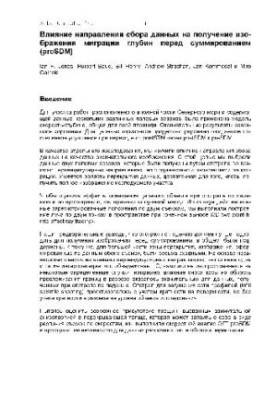Effect of the direction of data collection on the image of depth migration before summation
 Instant download
Instant download
after payment (24/7)
 Wide range of formats
Wide range of formats
(for all gadgets)
 Full book
Full book
(including for Apple and Android)
The book "The influence of data collection direction on obtaining images of depth migration before summation" by Jnos I. and other researchers - this is a unique and in-depth study that immerses the reader in the world of geophysics and seismology This work represents an important contribution to the field of seismic data processing, and it will be of interest to both professionals in this field and those who are just starting their way in the study of geosciences. The book focuses on the process of seismic data migration, which plays a key role in creating accurate images of underground structures. The authors consider in detail how the direction of data collection affects the quality and accuracy of the images received. This research is particularly relevant in light of the current challenges facing geophysicists, such as the need for accurate resource mapping and understanding of geological processes. The book offers readers not only a theoretical basis, but also practical recommendations, which makes it a valuable resource for specialists working in this field. Who can like this book? First of all, it will be of interest to students and graduate students studying geophysics, seismology and related disciplines . It will also attract the attention of professionals working in the oil and gas industry, as well as researchers engaged in geological surveys. If you are passionate about science and want to deepen your knowledge of how modern technologies help in studying the Earth, then this publication will be a real find for you. The topics raised in the book cover a wide range of issues, including methods of data processing, the impact of various factors on research results, and the application of the knowledge gained in real-world conditions. The authors emphasize the importance of accuracy in seismic surveys, which is directly related to the efficiency of resource extraction and the minimization of environmental risks. The book also raises questions about data interpretation and visualization, making it particularly relevant in the era of big data and digitalization. The style of the authors is clear and accessible, which allows even complex concepts to be explained in simple language. This makes the book not only a scientific work, but also a fascinating reading for anyone interested in the natural sciences. Jnoss I. and his colleagues use many examples and illustrations, which helps the reader to better understand the material and see the practical application of theoretical knowledge If you are interested in books such as “Seismic Interpretation” or “Methods of Geophysical Research”, then “The influence of the direction of data collection on obtaining an image of depth migration before summing up” will be a logical continuation for you. This edition will not only expand your horizons in the field of geosciences, but also inspire new research and discoveries. In conclusion, it is worth noting that the book of Jnoss and . and his colleagues is not just a scientific publication, but a real find for everyone who seeks to understand the complex processes taking place in the bowels of our planet. It opens new horizons in the study of seismic data and offers readers a unique opportunity to touch the advanced achievements of science. Don’t miss the chance to learn more about how the direction of data collection can change our perception of underground structures and processes!
LF/610729202/R
Data sheet
- Name of the Author
- Джнос И.
и др. - Language
- Russian


























